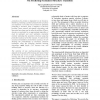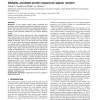119 search results - page 5 / 24 » Weave amino acid sequences for protein secondary structure p... |
IJBRA
2007
13 years 7 months ago
2007
A function of a protein is dependent on its structure; therefore, predicting a protein structure from an amino acid sequence is an active area of research. Optimally predicting a ...
BIOINFORMATICS
2010
13 years 7 months ago
2010
Motivation: To test whether protein folding constraints and secondary structure sequence preferences significantly reduce the space of amino acid words in proteins, we compared th...
JCB
2000
13 years 7 months ago
2000
We present a novel method for predicting the secondary structure of a protein from its amino acid sequence. Most existing methods predict each position in turn based on a local wi...
BIBE
2003
IEEE
14 years 23 days ago
2003
IEEE
Contact map prediction is of great interest for its application in fold recognition and protein 3D structure determination. In this paper we present a contact-map prediction algor...
BMCBI
2008
13 years 7 months ago
2008
Background: Prediction of transmembrane (TM) helices by statistical methods suffers from lack of sufficient training data. Current best methods use hundreds or even thousands of f...


